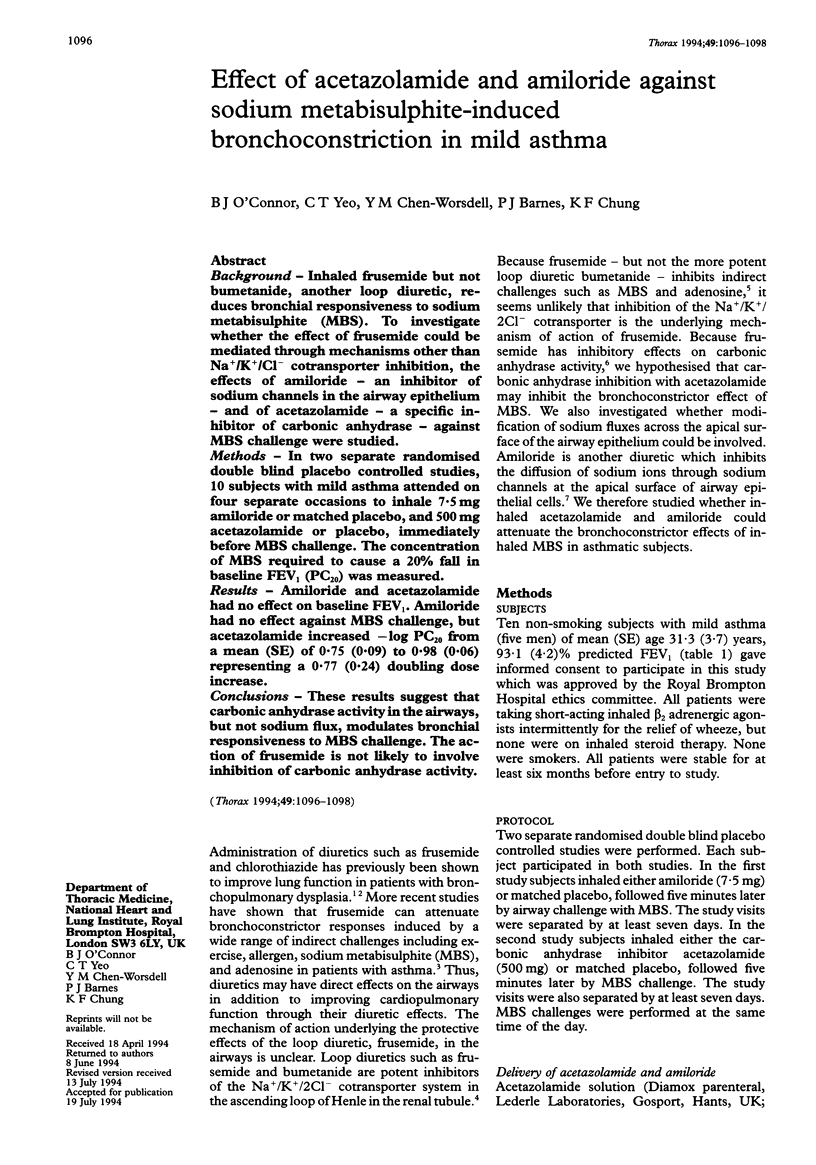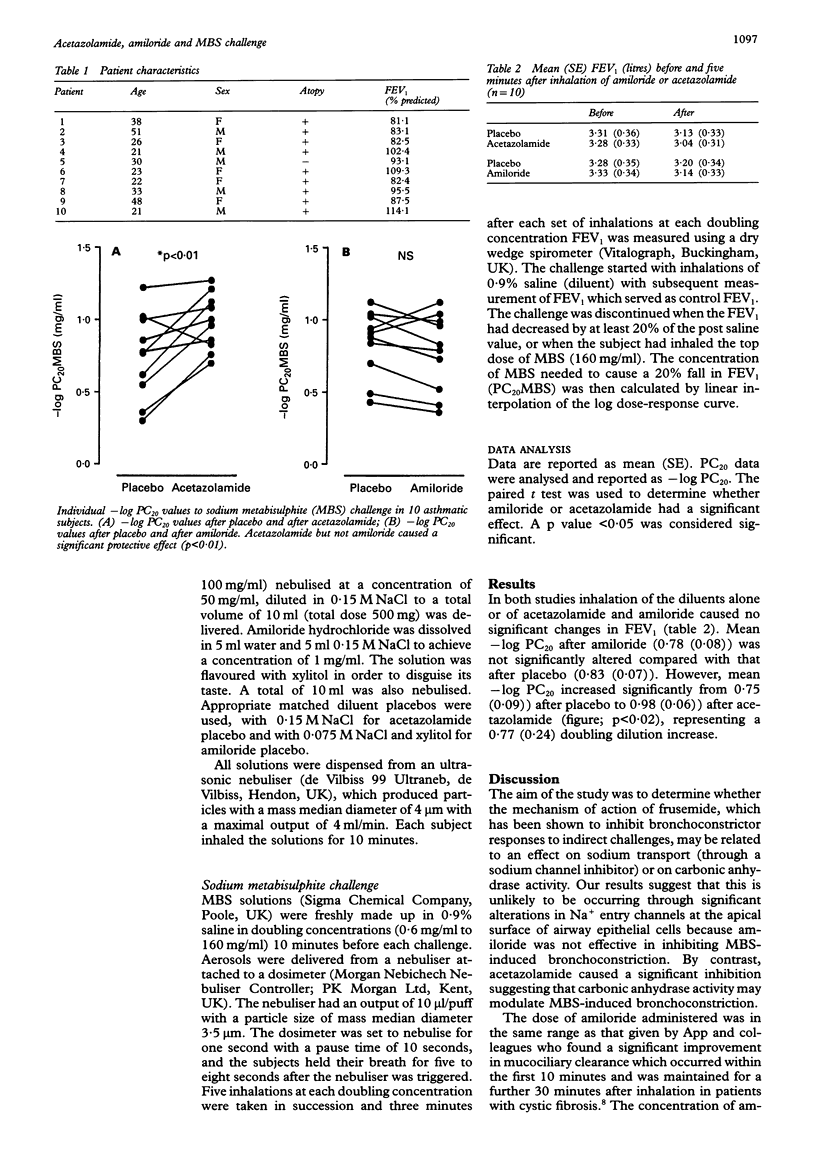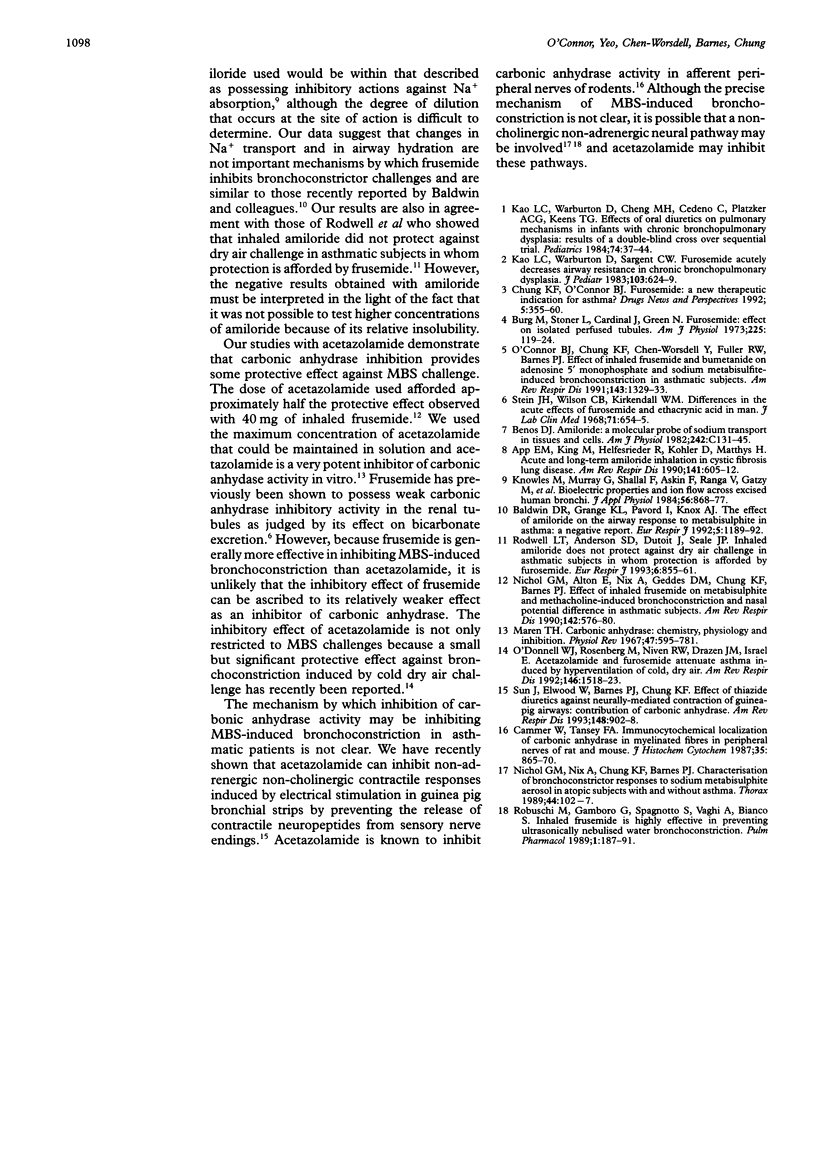Abstract
BACKGROUND--Inhaled frusemide but not bumetanide, another loop diuretic, reduces bronchial responsiveness to sodium metabisulphite (MBS). To investigate whether the effect of frusemide could be mediated through mechanisms other than Na+/K+/Cl- cotransporter inhibition, the effects of amiloride--an inhibitor of sodium channels in the airway epithelium--and of acetazolamide--a specific inhibitor of carbonic anhydrase--against MBS challenge were studied. METHODS--In two separate randomised double blind placebo controlled studies, 10 subjects with mild asthma attended on four separate occasions to inhale 7.5 mg amiloride or matched placebo, and 500 mg acetazolamide or placebo, immediately before MBS challenge. The concentration of MBS required to cause a 20% fall in baseline FEV1 (PC20) was measured. RESULTS--Amiloride and acetazolamide had no effect on baseline FEV1. Amiloride had no effect against MBS challenge, but acetazolamide increased -log PC20 from a mean (SE) of 0.75 (0.09) to 0.98 (0.06) representing a 0.77 (0.24) doubling dose increase. CONCLUSIONS--These results suggest that carbonic anhydrase activity in the airways, but not sodium flux, modulates bronchial responsiveness to MBS challenge. The action of frusemide is not likely to involve inhibition of carbonic anhydrase activity.
Full text
PDF


Selected References
These references are in PubMed. This may not be the complete list of references from this article.
- App E. M., King M., Helfesrieder R., Köhler D., Matthys H. Acute and long-term amiloride inhalation in cystic fibrosis lung disease. A rational approach to cystic fibrosis therapy. Am Rev Respir Dis. 1990 Mar;141(3):605–612. doi: 10.1164/ajrccm/141.3.605. [DOI] [PubMed] [Google Scholar]
- Baldwin D. R., Grange K. L., Pavord I., Knox A. J. The effect of amiloride on the airway response to metabisulphite in asthma: a negative report. Eur Respir J. 1992 Nov;5(10):1189–1192. [PubMed] [Google Scholar]
- Burg M., Stoner L., Cardinal J., Green N. Furosemide effect on isolated perfused tubules. Am J Physiol. 1973 Jul;225(1):119–124. doi: 10.1152/ajplegacy.1973.225.1.119. [DOI] [PubMed] [Google Scholar]
- Cammer W., Tansey F. A. Immunocytochemical localization of carbonic anhydrase in myelinated fibers in peripheral nerves of rat and mouse. J Histochem Cytochem. 1987 Aug;35(8):865–870. doi: 10.1177/35.8.3110266. [DOI] [PubMed] [Google Scholar]
- Chung K. F., Dent G., Barnes P. J. Effects of salbutamol on bronchoconstriction, bronchial hyperresponsiveness, and leucocyte responses induced by platelet activating factor in man. Thorax. 1989 Feb;44(2):102–107. doi: 10.1136/thx.44.2.102. [DOI] [PMC free article] [PubMed] [Google Scholar]
- Kao L. C., Warburton D., Cheng M. H., Cedeño C., Platzker A. C., Keens T. G. Effect of oral diuretics on pulmonary mechanics in infants with chronic bronchopulmonary dysplasia: results of a double-blind crossover sequential trial. Pediatrics. 1984 Jul;74(1):37–44. [PubMed] [Google Scholar]
- Kao L. C., Warburton D., Sargent C. W., Platzker A. C., Keens T. G. Furosemide acutely decreases airways resistance in chronic bronchopulmonary dysplasia. J Pediatr. 1983 Oct;103(4):624–629. doi: 10.1016/s0022-3476(83)80602-7. [DOI] [PubMed] [Google Scholar]
- Knowles M., Murray G., Shallal J., Askin F., Ranga V., Gatzy J., Boucher R. Bioelectric properties and ion flow across excised human bronchi. J Appl Physiol Respir Environ Exerc Physiol. 1984 Apr;56(4):868–877. doi: 10.1152/jappl.1984.56.4.868. [DOI] [PubMed] [Google Scholar]
- Maren T. H. Carbonic anhydrase: chemistry, physiology, and inhibition. Physiol Rev. 1967 Oct;47(4):595–781. doi: 10.1152/physrev.1967.47.4.595. [DOI] [PubMed] [Google Scholar]
- Nichol G. M., Alton E. W., Nix A., Geddes D. M., Chung K. F., Barnes P. J. Effect of inhaled furosemide on metabisulfite- and methacholine-induced bronchoconstriction and nasal potential difference in asthmatic subjects. Am Rev Respir Dis. 1990 Sep;142(3):576–580. doi: 10.1164/ajrccm/142.3.576. [DOI] [PubMed] [Google Scholar]
- O'Connor B. J., Chung K. F., Chen-Worsdell Y. M., Fuller R. W., Barnes P. J. Effect of inhaled furosemide and bumetanide on adenosine 5'-monophosphate- and sodium metabisulfite-induced bronchoconstriction in asthmatic subjects. Am Rev Respir Dis. 1991 Jun;143(6):1329–1333. doi: 10.1164/ajrccm/143.6.1329. [DOI] [PubMed] [Google Scholar]
- O'Donnell W. J., Rosenberg M., Niven R. W., Drazen J. M., Israel E. Acetazolamide and furosemide attenuate asthma induced by hyperventilation of cold, dry air. Am Rev Respir Dis. 1992 Dec;146(6):1518–1523. doi: 10.1164/ajrccm/146.6.1518. [DOI] [PubMed] [Google Scholar]
- Robuschi M., Gambaro G., Spagnotto S., Vaghi A., Bianco S. Inhaled frusemide is highly effective in preventing ultrasonically nebulised water bronchoconstriction. Pulm Pharmacol. 1989;1(4):187–191. doi: 10.1016/s0952-0600(89)80016-x. [DOI] [PubMed] [Google Scholar]
- Rodwell L. T., Anderson S. D., du Toit J., Seale J. P. Different effects of inhaled amiloride and frusemide on airway responsiveness to dry air challenge in asthmatic subjects. Eur Respir J. 1993 Jun;6(6):855–861. [PubMed] [Google Scholar]
- Stein J. H., Wilson C. B., Kirkendall W. M. Differences in the acute effects of furosemide and ethacrynic acid in man. J Lab Clin Med. 1968 Apr;71(4):654–665. [PubMed] [Google Scholar]
- Sun J., Elwood W., Barnes P. J., Chung K. F. Effect of thiazide diuretics against neurally mediated contraction of guinea pig airways. Contribution of carbonic anhydrase. Am Rev Respir Dis. 1993 Oct;148(4 Pt 1):902–908. doi: 10.1164/ajrccm/148.4_Pt_1.902. [DOI] [PubMed] [Google Scholar]


